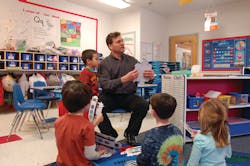Future Love
We went to our community’s National Night Out the other night where there were activities galore: games for kids to play, food being handed out and every community vehicle you could think of on display.
My 10-month-old son had a blast on the city bus. The giant steering wheel and the long aisle to crawl along won him over. There were other kids eagerly hopping around from seat to seat, especially wanting the driver’s seat or the back of the bus. I’m not sure at what age a city bus loses its fun.
Could be coincidence, but as you walked up to the park, prioritization already was in place. The great big shiny red fire truck was front and center. Further behind that and activities were the police cars, sheriff’s boat, and a SWAT Tactical Mobile unit. It was behind that, at the end of the line, where the bus was.
When you compare the perceived function, it probably doesn’t measure up to most. On one hand there’s a vehicle that coordinates operations of things in my community like a Slender Man stabbing or Azana Spa mass shooting. On the other, there’s a vehicle that provides transportation for those people that don’t work hard enough to own a car. Or something like that.
I’m not sure exactly what all of the phrasings are off the top of my head but I’ve read enough rants over the years from community members in the paper and on various local blogs.
I’ve made the mistake in the past of engaging one of those bloggers with facts that contradicted statements they had made. At an APTA marketing workshop several years ago, HDR Senior VP Alan Wulkan and Morgan Lyons, assistant VP, external relations, Dallas Area Rapid Transit, spoke during the luncheon about talking to stakeholders. I can attest to their statement that the few who’s minds you will never ever change, not worth the time and energy that you could be focusing elsewhere.
One of the places you should be focusing your time and energy? The next generation. There’s an article in this issue that looks at a pilot project by WTS: transportation professionals working with educators. Coming up with new and different ways of reaching the younger audience, future audience — and future voters — builds support and our future workforce.
